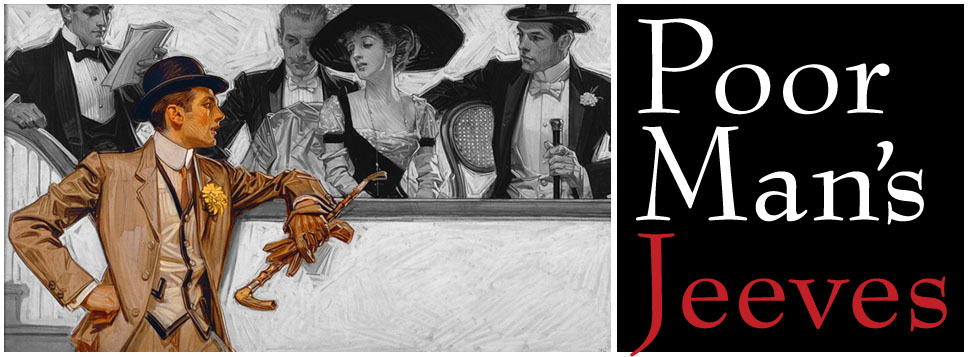For Men Learning to Dress
 My first aim is to help you learn how to dress by recommending some resources that will teach you the traditional standards. Those recommendations, printed and online, are all listed below. This is not a style blog with constant, new material; it points you to helpful materials. I suggest you read the book titles recommended below while developing a habit of regularly sweeping the web links you find most helpful and appealing. Do not feel rushed with this learning process. You will encounter all kinds of new vocabulary and ideas in the publications and on the blogs. Give yourself plenty of time to absorb it and eventually become fluent in the ideas of masculine style.
My first aim is to help you learn how to dress by recommending some resources that will teach you the traditional standards. Those recommendations, printed and online, are all listed below. This is not a style blog with constant, new material; it points you to helpful materials. I suggest you read the book titles recommended below while developing a habit of regularly sweeping the web links you find most helpful and appealing. Do not feel rushed with this learning process. You will encounter all kinds of new vocabulary and ideas in the publications and on the blogs. Give yourself plenty of time to absorb it and eventually become fluent in the ideas of masculine style.A Rich Man's Jeeves could simply tell you everything you need to do with advice personalized to you and your life. If you can afford one, do not hesitate to hire one. This is a Poor Man's Jeeves, and that means you need to do the work by studying the suggested resources and deciding what is right for you. By the same token, if you can afford bespoke (custom), I am not your best guide. A Poor Man's Jeeves aims to help a man make the most of ready-to-wear (off the rack) styles.
 The links below "For Your Education" offer sites I currently find useful. They should be swept regularly for advice, images and discussion. Some of them are rather active. Others that are less active have enough advice I still value in earlier posts to warrant me keeping them. Most of the links have quite a bit to offer in their archives worthy of exploring. I do occasionally delete links that no longer inspire me, so if you find one particularly useful, I suggest you bookmark it.
The links below "For Your Education" offer sites I currently find useful. They should be swept regularly for advice, images and discussion. Some of them are rather active. Others that are less active have enough advice I still value in earlier posts to warrant me keeping them. Most of the links have quite a bit to offer in their archives worthy of exploring. I do occasionally delete links that no longer inspire me, so if you find one particularly useful, I suggest you bookmark it.In addition to these linked sources, make the most of tools like Google and YouTube. The internet is full of resources (of wildly varying quality) like videos teaching you how to polish your shoes, knot your ties, fold a pocket square, and countless other things. There are many generous people out there willing to serve as your Poor Man's Jeeves.
II. The History and Elements of Men's Style
III. Having the Right Perspective on Style
The last thing I offer is my perspective on how you might want to develop your style. When you read the resources suggested here it is easy to gain the impression that you need to start wearing suits, ties, and perhaps even hats, collar pins, and a monocle to be well-dressed. You do not. And you really should not if you do not inhabit social spheres where others do.
Understand that dressing well and dressing up are two entirely different things. Dressing up means wearing clothes that are higher on the ladder of formality. It is certainly important to understand when and how to dress up, which is why I offer the best resources I have found to help you do so. Dressing well, though, is not the same thing and means making sure that the garments you are wearing are perfectly appropriate to occasion, that their fit, construction, materials, and combination are the best possible - at any level of formality. See the following link for more detail on what it means to dress well.
You can be higher up on the ladder of formality, say in a tux, but the fit, materials, and quality you have chosen could all be atrocious (see any high school prom for examples). This would be dressing up but not dressing well. Alternatively, if you work at a place where all of your peers wear chinos (khakis) and polos, you can make sure that your pants fit you perfectly, as does your polo, that they have the highest quality construction and materials you can acquire, and that the colors you have selected look great on you. Your shoes, while appropriate to this level of formality, can also have the best materials and construction possible for you and coordinate perfectly with what you are wearing. In this combination you would be dressing well without dressing up.
This means if you work in a world where nobody wears suits or even ties, probably what I and many call Business Casual, do not start wearing them to work or to see friends. (See the following link for advice on dressing your best in Business Casual.) Wear clothes of the same formality as your peers' clothes, just do it much better. This goes for every sphere of your life and every occasion in which you ever find yourself.
I hope the resources and advice offered here serve you.


